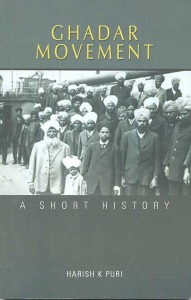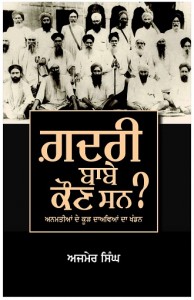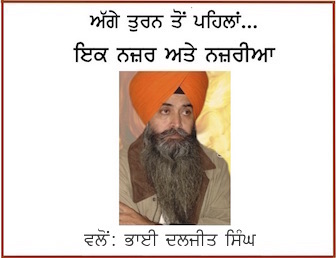Articles/Opinion
Distorting Indian Freedom Struggle History to Strengthen Indian Nationalism anchored to Hindu Religious Ethos
October 14, 2013 | By Jaspal Singh Sidhu
Current centenary year of the Ghadar Party, founded in America in March, 1913 by Indians of Punjab origin with overwhelming participation of the Sikhs to level of 96-97 per cent has not remained confined to customary celebrations. American historian Johanna Jo Ogden who recently finished her five-year unpaid research in Portland and Astoria areas (USA) where the emigrant Sikh lived before joining the Ghadar Party , has published her studies in ‘Oregon Historical Quarterly’ (a report in Portland Tribune). Diaspora Sikh researchers and their counterparts In Indian Punjab, also got prompted to re-evaluate the ‘Ghadar’ (uprising) episode and claimed that their investigations have thrown up altogether a different picture than what was, till recently, prevailed and projected by the historians. Five-six years ago, activists of the Ghadar party were being taken as ‘staunch nationalist Indians who transgressed communitarian and religious trappings’. And those intellectuals who brought out ‘other side of the story’ to the fore, have raised an accusing finger on the erstwhile historians of the Ghadar Party blaming them for “willful distortion the history of freedom struggle as to make it subservient to the Indian Nationalism anchored to Hindu religious ethos”.
Researchers and historians coming out with new version of the Ghadar history have contend that the distortion began with Sohan Singh Josh, earlier Communist activist of 1920-30s era, who was obsessed with ‘’ mechanical materialistic interpretation of ‘communalism’, a third-rate version of Euro-centric secularism ‘’. On becoming the editor of the Kirti Party’s newspaper after the death of its founder editor Santokh Singh, former general secretary of the Ghadar Party who had come down to Amritsar following failure of the Ghadar movement, Josh made a deliberate bid to detach the newspaper from Ghadari Babas (older activists of the Ghadar movement) who were practicing Sikhs had drawn their revolutionary fervor from the Sikh history and religious-cultural moorings. Those days in Punjab, divide between the Kirti Party comprising most of the Ghadari Babas and the Communist party of which Josh was a member, continued to smolder even though both had joined hands on various anti-British agitation programs. Another pertinent difference between the two was that the Ghadari Babas were having closer and warm relations with leaders of the Akali Party, a political outfit of the Sikhs that came into existence in 1920s while the Communists were nursing a strong aversion to the Sikh religion and the Sikh way of life which their cadres are having till the day.
Being molded in that Communist culture , Josh was the first to begin with the distortion of the Ghadar Party’s history projecting Babas as “nationalists and seculars’’ in his earlier write-ups much before gaining a reckoning of being a third writer to pen down a comprehensive history of Ghadarites as late as in 1978 . Earlier to Josh, Gurcharn Singh Sainsara, another Left activist wrote the history of the Ghadar Party in 1960s, painting Ghadari Babas as “Left-leaning secular nationalists having no truck with the Alkalis ”. Before him, Jagjit Singh, author of a path-breaking Sikhs’ history book, “The Sikh Revolution” was the first historian to write the history of the Ghadarites. His book “Ghadar Party Lehar” came out in late 1950s but he, too, being under the Left intellectuals’ influence could not do much justice to the Ghadar movement.
Sainsara wrote the history in Punjabi language (Gurmukhi script) while Josh penned it down originally in English, later, to be translated into Punjabi. Prof Harish Kumar Puri was the first academician to write on the Ghadar Party in English whose historical works got recognition throughout the country and abroad. Puri painted the ‘Ghadari Babas’ as ‘secular nationalists who had shunned all sort of communal feelings and detached themselves from their Sikh background’. And, Left activists and their supporting intellectuals do hail Puri’s historical writings as “an objective and authentic evaluation of the role of Ghadar Party”.
Puri presented Lala Hardyal as ‘brain behind the Ghadar movement’. Lala Hardyal was inspired by the Bengali Hindu nationalists like Bankum Chatterjee and Arbindo Ghosh and VD Savarkar , the founder of RSS and Hindutva political ideology and he convinced the Ghadarites to adopt “Bande-Matrim” as their slogan and named the headquarter of their newspaper ‘ Gadhar ’ in San Frasisco as “Yugantar Ashram”. Ironically most of the Ghadari leaders from Punjab were not aware about the anti-Muslim texture of ‘Bande-Matrim’ slogan as it had originated in the Bangla traditions and culture.Otherwise, they would not have adopted it as Baba Sohan Singh Bhakna, founder president of Ghadar Party himself corroborated this fact in his auto-biography, ‘Meri Ram Kahani’, that they were keen to keep Indian Muslims in Gadhar Party’s fold and kept one in the party (in US) even as his credentials were doubtful ………..we adopted the slogan thinking that it belonged to none of the participants and help them remaining united.’ Puri conveniently used innocence on the part of the Ghadarites on this count to come out with his intended conclusion that the adoption of ‘Bande-Matrim’ proved the nationalistic credentials of the Ghadari Babas as the Sikhs among them had abjured their religious background and slogans like that of ‘’Bole So Nihal’.
Of late, Sewak Singh, a research scholar of Punjabi University Patiala during his course study raised a mild finger on hitherto accepted version of history of the Ghadar Party and wrote a critical article on the subject in a Punjabi weekly ‘Sikh Shahaadat’. That article inspired the Sikh intellectuals to explore the facts ‘why the Sikhs had overwhelmingly joined the Ghadar Party?’ and ‘why the Sikhs had constituted the majority of those executed and sent to Adaman and other jails?’. These queries prompted inquisitive Rajwinder Singh Raahi to take up a serious study of the Ghadar movement. In a short period, dedicated Raahi researched the records, dished out old documents and authored three books on the subject— Ghadar Lehar Di Asli Gatha (Real Story Behind Ghadar Movement)—Part 1 and Part 2 and “Meri Ram Kanani” –an autobiography of Baba Sohan Singh Bhakna, the founder president of “Hind Association of Pacific Coast” which later came to known as “Hindustan Ghadar Party” or “Ghadar Party”.
Meanwhile , Ajmer Singh, a Sikh historian and author of three highly acclaimed books on ‘Sikhs in History and politics of Post-Independent India’ who guided and actively collaborated with Raahi in latter’s research project has also come out with his new book on the Ghadar Party,
“Ghadari Babe Kaun San? Anmattiya De Kur Dahvihayan Da Khandan” (Who were Ghadari Babas? Rejection of Distorted Claims) in Punjabi (Gurmukhi script). This book rejects the historicity hitherto built around the Ghadar movement and presents new and hitherto unknown facts shredding to pieces the traditional interpretation from Indian nationalistic perspective.
“Till 2006, I also was of the conviction – as prevailing and largely acceptable – that Ghadari Babas had leftist orientation or they were influenced by other ideologies and movements in the world while remaining detached from Sikhism, its history and ethos. It was during my work on another book that I started realizing this perception was away from the truth. Then other material also started coming out, which threw fresh light on the orientation of the movement,” says Ajmer Singh, a former Naxal (Ultra Communist) leader of Punjab, who remained underground for 31 years from 1970 to 2001.
Apart from referring to several works, Ajmer has quoted extensively from great Bengali revolutionary Sachindra Nath Sanyal’s autobiography ‘Bandi Jiwan’.
“We have challenged the prevailing thesis, and now let there be honest answers to our works after the original writings of the Ghadarites have been published,” adds Ajmer Singh.
Rebutting criticism by the Left intellectuals that he is bent upon presenting the Ghadarites as the Sikh faithful, Ajmer Singh dishes out the facts that leaving a few Hindu and Muslim participants in the Ghadhar movement as many as 96-97 per cent were the Sikhs from Punjab, particularly, from Lahore, Amrtisar, Gurdaspur, Ferozepur and Ludhiana districts of the central Punjab dominated by the Sikhs agriculturists.
Rejecting Puri’s contention that the Ghadari Babas had dissolved their Sikh identity into a pan-Indian identity, Ajmer’s book quotes historical facts extensively affirming the warm relations of the Gadhari Babas with the Sikh Gurdwara Parbandhak Committee (SGPC), a statutory body that manages the Sikh religious affairs and the Akali Dal. Installation of the Ghadari Baba, Waisakha Singh as Jathedar (Religious Head) of the Akal Takht (High Temporal Seat among the Sikhs) in 1930s was a proof of that. In support of contention Ajmer also quotes eminent Marxist thinker, Prof Randhir Singh who wrote a pamphlet on the Ghadar movement in 1945 underlining the popularity of Ghadari Babas among the Sikhs.“ The Sikh Panth has chosen Baba (Baba Waisakha Singh) as Jathedar of the Akal Takht…. who is most respected personality and a household- name among the Sikh farmer families. Heroic tales of Ghadari Babas like that of Baba Gurmukh Singh Lalto are on the lips of Sikh children in Punjab. Heroic deeds of immortal Kartar Singh Sarabha and his companions are sung by the Sikh farmer families.” Prof Singh, thus, presents an indisputable testimony to the fact that the majority of Ghadarites were hailing from Sikh farming families and they had settled in their native villages following their escape from gallows and release from prisons. Later, the proposing of Sohan Singh Bhakna as an unanimous choice for the office of the SGPC president by the SGPC members in 1936 goes to testify that the Ghadarites remained staunch Sikhs and closer to the Sikh leadership. Anyhow, the proposal fell through at the eleventh hour because of some extraneous factors.
Most of people from the Sikh families, no doubt, forced to leave for US and Canada, Malaya islands and China because of economic stress back home as being explained by Marxists like that of Dr Jaspal Singh editor Des Sewak, a Punjabi newspaper but their urge for freedom from the British yoke back home was stirred up by politically free environment of the US particularly where the British Imperial rule was overthrown through armed resurrection. Sikh religious ethos and Sikh historical background impelled them to confront, instead of submitting to, the racial and cultural humiliation they faced in Canada and other foreign lands, thereby, sharpening their determination for securing justice to the level of taking up arms against the British rule. Otherwise, thousands of other Indians were out there for earning bread and better for their families but they did not join the Ghadar Party to jump into armed fray for ending the slavery of Indian by the British.
Ajmer Singh raises another pertinent question; ‘ what perturbed solely the Sikhs so much that five to six thousands of them from America, Singapore, Malaysia, China and other countries had joined the Ghadar Party and came down to India to overthrow the British rule while a few other Indians (non-Sikh) joined them ?’’ And ‘were the Sikhs still sulking and repining over the loss of Khalsa Raj in Punjab to the British?’ In the end, ‘how come among 150 Punjabis sent to gallows and executed and more than 300 of them sent to Andaman and other jails after the unsuccessful bid of the Ghadarties an overwhelming majority were the Sikhs whose population was only 6 to 7 percent in the undivided Punjab and around one per cent in the entire Indian sub-continent?’. He points out pertinently that sacrifices made by other than Sikhs in the early period of freedom struggle is countable on fingers. And ‘what were characteristics of the Sikhs which impelled them to take up arms against the British when the Congress leaders were still dreaming of achieving a ‘dominion status’ for India?’ Ajmer contested the traditional projection of the Ghadarites as being too foolhardy and head strong to take into account the indifference of the native Indian people towards their mission. They , says Ajmer, were fully alive to Indian and international situation and had developed good secret contacts with the Sikh regiments which would have revolted at a crucial period when the British Empire was pre-occupied with the first World War. ‘Only armchair historians could question the strategy of the Ghadar Party since such intellectuals are supposed to have no direct experience of actual revolt and armed struggles’.
Projection of Lal Hardyal as ‘brain’ behind, the Ghadar movement has also been disputed by Ajmer as ‘an implicit attempt to reject and subsume the Sikh identity of the Ghadar leaders into pan-Indian identity’. He quotes Baba Bhakna as saying in his autobiography that ‘Lala Hardyal was most intelligent person but had no consistency and perseverance of a fighter ………..and he was hired only to edit the Ghadar newspaper where he worked only for six months ……..and then left for Germany thereafter not to come back to US again’. During stay in Germany, Lala Hardyal lost his earlier anti-British fervor, rather, began singing paeans of the British and later wrote a book in their praise which was freely distributed in India by the British administration. Ajmer contends that Lala Hardyal ,rather, trapped the Ghadar Party leaders into adopting “Bande-Matrim’ slogan—- an anti-Muslim and Hindu ultra-nationalist war cry and naming of the Ghadar Party’s headquarter as “Yugantar Ashram’’, a Bengali Nationalists’ coinage.
A critique of traditional history presented in the book could be summed up as: “ the Ghadar history was distorted by the way of appropriating and co-opting the historic role of real freedom fighters as pan-Indian phenomenon in Indian nationalistic perspective as to help the Nation State building project laced to the majority cultural and historical hegemony. And, the Left intellectuals have been collaborator of Indian national elite in this project. Communists from Punjab, invariably, helped in muddling up the history which for them began from 1920s as if they have nothing do with what had happened prior to that”.
S. Jaspal Singh Sidhu retired as a Special Correspondent with UNI, New Delhi in 2008. Since then, has been writing on political, historical affairs and agricultural issues. He can be reached at [email protected]
To Get Sikh Siyasat News Alerts via WhatsApp:
(1) Save Our WhatsApp Number 0091-855-606-7689 to your phone contacts; and
(2) Send us Your Name via WhatsApp. Click Here to Send WhatsApp Message Now.
Sikh Siyasat is on Telegram Now. Subscribe to our Telegram Channel
Related Topics: Gadhar Movement, Jaspal Singh Sidhu, Sikh Author and Political Analyst Bhai Ajmer Singh






